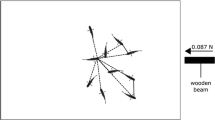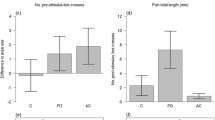Abstract
The ability to discriminate between more dangerous and less dangerous predators can have serious fitness advantages for fish juveniles. This is especially true for hatchery-reared fish young used for stocking, because their post-release mortality is often much higher than that of wild-born conspecifics. We tested whether two coexisting fish predators and their different diets induce innate behavioral responses in predator-naive Arctic charr (Salvelinus alpinus) young originating from an endangered hatchery-bred population used for re-introductions. We predicted the antipredator responses of charr to be stronger towards chemical cues of brown trout (Salmo trutta) and pikeperch (Stizostedion lucioperca) than towards odorless control water. More pronounced antipredator behavior was predicted in treatments with predators fed on charr than when their diet consisted of another sympatric salmonid, European grayling (Thymallus thymallus), or when they were food-deprived. The Arctic charr young showed strong antipredator responses in all brown trout treatments, whereas odors of the less likely predator pikeperch were avoided with conspecific diet only. Freezing was the most sensitive antipredator behavior, as it was completely absent in control treatments. We found considerable individual variation in the amount and strength of antipredator responses. Although almost half of the charr failed to show antipredator behavior towards the piscivores, those with the innate ability showed highly sensitive recognition of predator odors. Our results indicate that the innate antipredator behavior of the juvenile fish is already finely tuned to respond specifically to chemical cues from different fish predators and even their diets.




Similar content being viewed by others
References
Berejikian BA, Smith RJF, Tezak EP, Schroder SL, Knudsen CM (1999) Chemical alarm signals and complex hatchery rearing habitats affect antipredator behavior and survival of chinook salmon (Oncorhynchus tshawytscha) juveniles. Can J Fish Aquat Sci 56:830–838
Berger J (1998) Future prey: Some consequences of the loss and restoration of large carnivores. In: Caro T (ed) Behavioral ecology and conservation biology. Oxford University Press, New York, pp 80–103
Breden F, Scott MA, Michel E (1987) Genetic differentiation for anti-predator behavior in the Trinidad Guppy. Anim Behav 35:618–620
Brodie ED Jr, Formanowick DR Jr, Brodie ED III (1991) Predator avoidance and antipredator mechanisms: distinct pathways to survival. Ethol Ecol Evol 3:73–77
Brown C, Day R (2002) The future of stock enhancements: Bridging the gap between hatchery practice and conservation biology. Fish Fisheries 3:79–94
Brown C, Laland KN (2001) Social learning and life skills training for hatchery reared fish. J Fish Biol 59:471–493
Brown C, Warburton K (1997) Predator recognition and anti-predator responses in the rainbowfish Melanotaenia eachamensis. Behav Ecol Sociobiol 41:61–68
Brown GE, Chivers DP, Smith RJF (1995) Fathead minnows avoid conspecific and heterospecific alarm pheromones in the faeces of northern pike. J Fish Biol 47:387–393
Brown GE, Godin J-GJ (1997) Anti-predator responses to conspecific and heterospecific skin extracts by threespine sticklebacks: alarm pheromones revisited. Behavior 134:1123–1134
Brown GE, Smith RJF (1996) Foraging trade-offs in fathead minnows: acquired predator recognition in the absence of an alarm response. Ethology 102:776–785
Brown GE, Smith RJF (1998) Acquired predator recognition in juvenile rainbow trout (Oncorhynchus mykiss): conditioning hatchery-reared fish to recognize chemical cues of a predator. Can J Fish Aquat Sci 55:611–617
Chivers DP, Smith RJF (1994) Fathead minnows (Pimephales promelas) acquire predator recognition when alarm substance is associated with the sight of unfamiliar fish. Anim Behav 48:597–605
Chivers DP, Brown GE, Smith RJF (1995) Acquired recognition of chemical stimuli from pike, Esox lucius, by brook sticklebacks, Culaea inconstans (Osteichthyes, Gasterosteidae). Ethology 99:234–242
Commens AM, Mathis A (1999) Alarm pheromones of rainbow darters: responses to skin extracks of conspecifics and congeners. J Fish Biol 55:1359–1362
Dellefors C, Johnsson JI (1995): Foraging under risk of predation in wild and hatchery-reared juvenile sea trout (Salmo trutta). Nord J Freshw Res 70:31–37
Dill LM, Fraser AHG (1984) Risk of predation and the feeding behavior of juvenile coho salmon (Oncorhynchus kisutch). Behav Ecol Sociobiol 16:65–71
Edge KA, Townsend CR, Crowl TA (1993) Investigating antipredator behavior in three genetically differentiated populations of non-migratory galaxiid fishes in a New Zealand river. NZ J Mar Freshw Res 27:357–363
Fernö A, Järvi T (1998) Domestication genetically alters the anti-predator behavior of anadromous brown trout (Salmo trutta) – a dummy predator experiment. Nord J Freshw Res 74:95–100
FitzGibbon CD (1994) The costs and benefits of predator inspection behavior in Thomsons's gazelles. Behav Ecol Sociobiol 34:139–148
Fuiman LA, Magurran AE (1994) Development of predator defenses in fishes. Rev Fish Biol Fish 4:145–183
Godin J-GJ (1986) Antipredator function of shoaling in teleost fishes: a selective review. Nat Can 113:241–250
Godin J-GJ, Classon LJ, Abrahams MV (1988) Group vigilance and shoal size in a small charracin. Behavior 104:29–40
Gotceitas V, Godin J-GJ (1991) Foraging under the risk of predation in juvenile Atlantic salmon (Salmo salar L.): effects of social status and hunger. Behav Ecol Sociobiol 29:255–261
Griffin AS, Blumstein DT, Evans CS (2000) Training captive-bred or translocated animals to avoid predators. Conserv Biol 14:1317–1326
Hara TJ (1993) Role of olfaction in fish behavior. In: Pitcher TJ (ed) The behavior of teleost fishes, Croom Helm, London, pp 152–176
Hirvonen H (2001) How to restore Arctic charr in Lake Saimaa? In: Grönlund E, Viljanen M, Juvonen P, Holopainen IJ (eds) Seminar on large lakes 2001 - Environment and Society. University of Joensuu. Publ Karelian Inst 133:274–278
Hirvonen H, Ranta E, Piironen J, Laurila A, Peuhkuri N (2000) Behavioral responses of naïve Arctic charr to chemical cues from salmonid and non-salmonid fish. Oikos 88:191–199
Huntingford FA, Wright PJ, Tierney JF (1994) Adaptive variation in antipredator behaviour in threespine stickleback. In: Bell MA, Foster SA (eds) The evolutionary biology of the threespine stickleback. Oxford University Press, Oxford, pp 277–296
Järvi T, Uglem I (1993) Predator training improves the anti-predator behavior of hatchery reared Atlantic salmon smolt. Nord J Freshw Res 68:63–71
Johnsson JI (1993) Big and brave: size selection affects foraging under risk of predation in juvenile rainbow trout, Oncorhynchus mykiss. Anim Behav 45:1219–1225
Johnsson JI, Petersson E, Jönsson E, Bjönsson BT, Järvi T (1996) Domestication and growth hormone alter antipredator behavior and growth patterns in juvenile brown trout, Salmo trutta. Can J Fish Aquat Sci 53:1546–1554
Kats LB, Dill LM (1998) The scent of death: chemosensory assessment of predation risk by prey animals. Ecoscience 5:361–394
Keefe ML (1992) Chemically mediated avoidance behavior in wild brook trout, Salvelinus fontinalis: the response to familiar and unfamiliar predaceous fishes and the influence of fish diet. Can J Zool 70:288–292
Keefe M, Winn HE (1991) Chemosensory attraction to home stream water and conspecifics by native brook trout, Salvelinus fontinalis, from two southern New England streams. Can J Fish Aquat Sci 48:938–944
Kieffer JD, Colgan PW (1992) The role of learning in fish behaviour. Rev Fish Biol Fish 2:125–143
Krebs JR, Davies NB (eds) (1993) Living in groups. In: An introduction to behavioral ecology. Blackwell, Oxford, pp 120–146
L'Abée-Lund JHL, Langeland A, Saegrov H (1992) Piscivory by brown trout Salmo trutta L. and Arctic charr Salvelinus alpinus (L.) in Norwegian lakes. J Fish Biol 41:91–101
Landeau L, Terborgh J (1986) Oddity and the 'confusion effect' in predation. Anim Behav 34:1372–1380
Laurila A, Peuhkuri N, Seppä T, Piironen J, Hirvonen H, Ranta E (1998) Differentially directed startle responses in alevins of three salmonid species. Ann Zool Fenn 35:17–19
Lawler SP (1989) Behavioural responses to predators and predation risk in four species of larval anurians. Anim Behav 38:1039–1047
Liley NR (1982) Chemical communication in fish. Can J Fish Aquat Sci 39:22–35
Lima SL, Dill LM (1990) Behavioral decisions made under the risk of predation: a review and prospectus. Can J Zool 68:619–640
Magnhagen C (1988) Changes in foraging as a response to predation risk in two gobiid fish species, Pomatoschistus minutus and Gobius niger. Mar Ecol Prog Ser 49:21–26
Magurran AE (1986) Predator inspection behavior in minnow shoals: differences between populations and individuals. Behav Ecol Sociobiol 19:267–273
Magurran AE (1986) Predator inspection behavior in minnow shoals: differences between populations and individuals. Behav Ecol Sociobiol 19:267–273Magurran AE (1989) Acquired recognition of predator odor in the European minnow. Ethology 82:216–223
Magurran AE (1990a) The adaptive significance of schooling as an anti-predator defence in fish. Ann Zool Fenn 27:51–66
Magurran AE (1990a) The adaptive significance of schooling as an anti-predator defence in fish. Ann Zool Fenn 27:51–66Magurran AE (1990b) The inheritance and development of minnow anti-predator behavior. Anim Behav 39:834–842
Magurran AE (1999) The causes and consequences of geographic variation in antipredator behavior. In: Foster SA, Endler JA (eds) From geographic variation in behavior perspectives on evolutionary mechanisms. Oxford University Press, London, pp 139–163
Magurran AE, Seghers BH (1990) Population differences in predator recognition and attack cone avoidance in the guppy (Poecilia reticulata). Anim Behav 40:443–452
Maitland PS, Campbell RN (1992) Freshwater fishes. Harper Collins, London
Makkonen J (1997) Saimaa Arctic charr, the threatened deep water fish (in Finnish with English summary). Finnish Game and Fisheries Research Institute. Kalantutkimuksia 133
Mathis A, Smith RJF (1993a) Intraspecific and cross-superorder responses to chemical alarm signals by brook sticklebacks. Ecology 74:2395–2404
Mathis A, Smith RJF (1993b) Chemical alarm signals increase the survival time of fathead minnows during encounters with northern pike. Behav Ecol 4:260–265
Mathis A, Smith RJF (1993c) Fathead minnows (Pimephales promelas) learn to recognise pike (Esox lucius) as predators on the basis of chemical stimuli from minnows in the pike's diet. Anim Behav 46:645–656
Olla BL, Davis MW (1989) The role of learning and stress in predator avoidance of hatchery-reared coho salmon juveniles. Aquaculture 76:209–214
Olla BL, Davis MW, Ryer CH (1994) Behavioural deficits in hatchery-reared fish: potential effects on survival following release. AquacultFish Manage 25 [Suppl 1]:19–34
Petterson LB, Brönmark C (1993) Trading off safety against food: state dependent habitat choice and foraging in Crusian carp. Oecologia 95:353–357
Pitcher TJ, Parrish JK (1993) Functions of shoaling behavior in teleosts. In: Pitcher TJ (ed) Behavior of teleost fishes. Chapman & Hall, London, pp 363–440
Quinn TP, Tolson GM (1986) Evidence of chemically mediated population recognition in coho salmon (Oncorhynchus kisutch). Can J Zool 64:84–87
Rassi P, Alanen A, Kanerva T, Mannerkoski I (eds) (2001) Suomen lajien uhanalaisuus 2000. Ympäristöministeriö & Suomen ympäristökeskus, Helsinki
Reznick D, Bryga H, Endler JA (1990) Experimentally induced life-history evolution in a natural population. Nature 346:357–359
Smith RJF (1981) Effect of food deprivation on the reaction of Iowa darters (Etheostoma exile) to skin extract. Can J Zool 59:558–560
Smith RJF (1997) Avoiding and deterring predators. In: Godin J-GJ (ed) Behavioral ecology of teleost fishes. Oxford University Press, London, pp 163–190
Smith RJF, Lawrence BJ, Smith MJ (1991) Cross-reactions to skin extract between two gobies, Asterropteryx semipunctatus and Brachygobius sabanus. J Chem Ecol 17:2253–2259
Sokal RR, Rohlf FJ (eds) (1995) Biometry. Freeman, New York
Weldon PJ (1990) Responses by vertebrates to chemicals from predators. In: MacDonald DW, Müller-Schwarze D, Silverstein RM (eds) Chemical signals in vertebrates. Plenum, New York, pp 500–521
Wisenden BD, Chivers DP, Brown GE, Smith RJF (1995) The role of experience in risk assessment: avoidance of areas chemically labelled with fathead minnow alarm pheromone by conspecifics and heterospecifics. Ecoscience 2:116–122
Zar JH (1996) Biostatistical analysis. Prentice-Hall, Upper Saddle River, N.J.
Acknowledgements
We thank M. Saastamoinen for assisting in the observations, and N. Peuhkuri, A. Salonen, K. Enberg and K. Lahti for discussion. Dr. P.H. Enckell is acknowledged for reading an earlier draft. A special thanks goes to Saimaa Fisheries Research and Aquaculture for the facilities and fish. The Academy of Finland and the Nordic Council of Ministers funded the study.
Author information
Authors and Affiliations
Corresponding author
Additional information
Communicated by J. Krause
Rights and permissions
About this article
Cite this article
Vilhunen, S., Hirvonen, H. Innate antipredator responses of Arctic charr (Salvelinus alpinus) depend on predator species and their diet. Behav Ecol Sociobiol 55, 1–10 (2003). https://doi.org/10.1007/s00265-003-0670-8
Received:
Revised:
Accepted:
Published:
Issue Date:
DOI: https://doi.org/10.1007/s00265-003-0670-8




